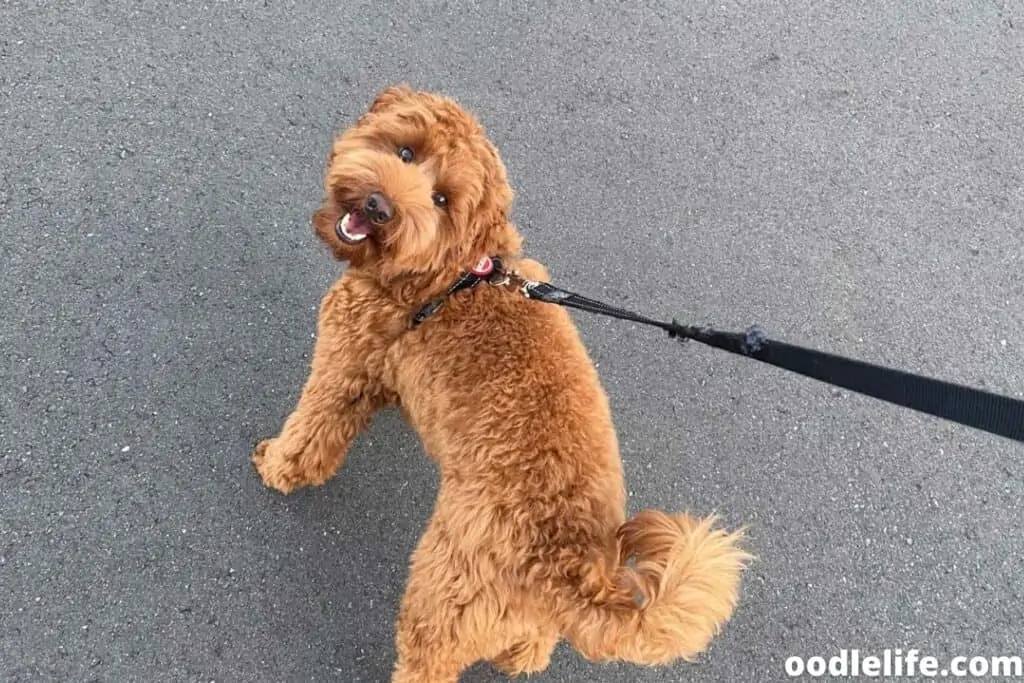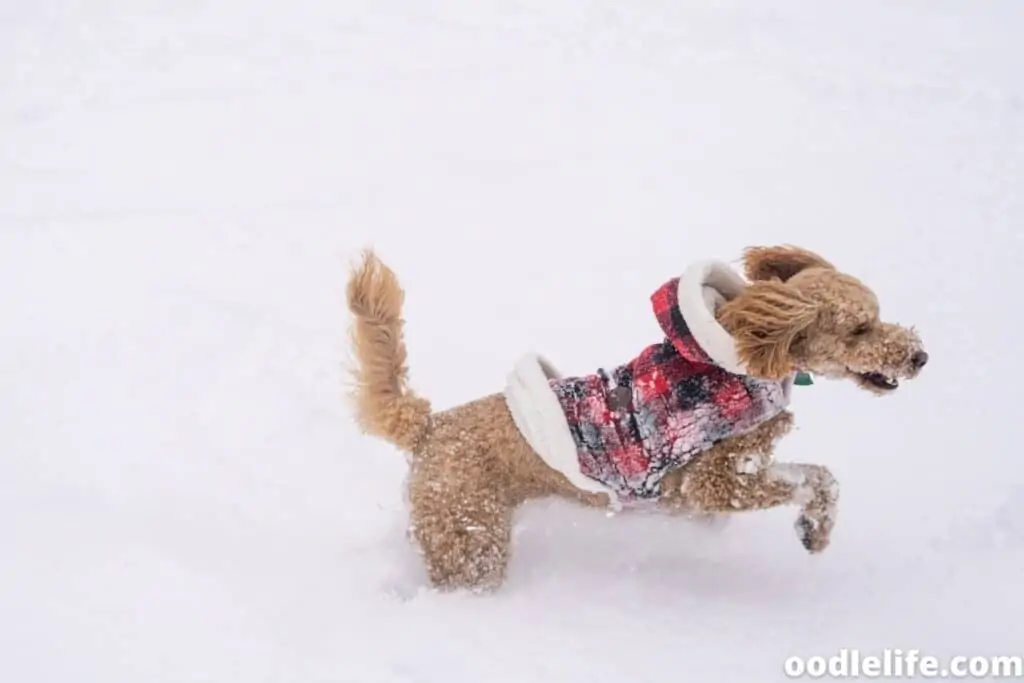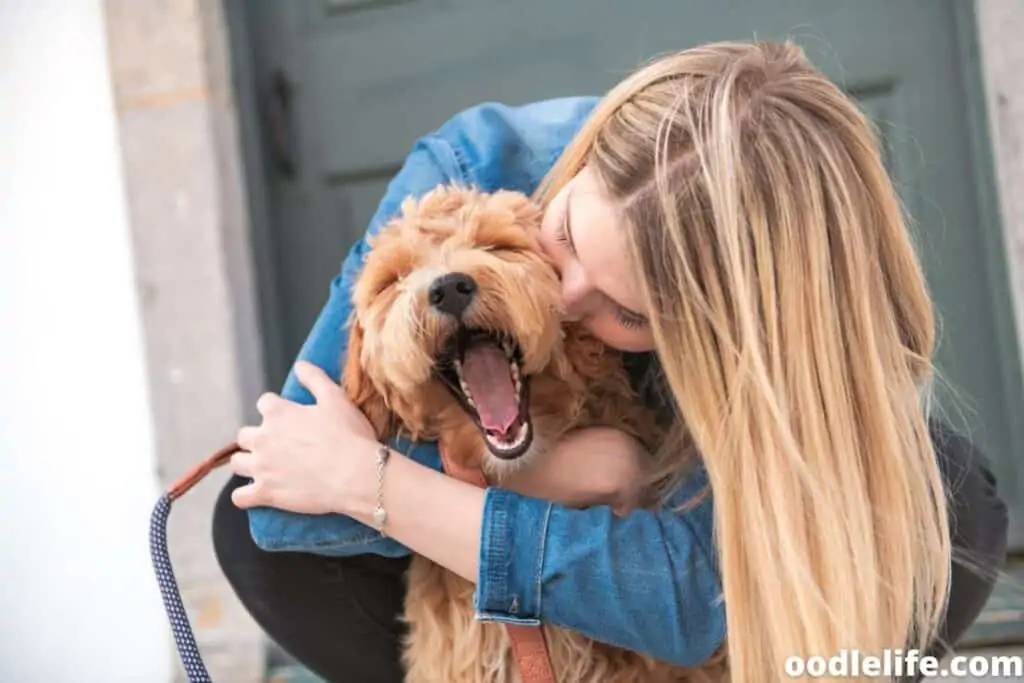How Far Can a Labradoodle Walk?
Labradoodles can be a terrific companion for your daily walks or to take on long hikes. Alternatively, you do not want to overwork your dog, which can cause him discomfort or pain.

The age of your pet will help guide you on how far your Labradoodle can walk each day. By following a proper exercise regime, you can keep your dog healthy and happy for many years.
Why Should I Limit My Labradoodle’s Exercise?

Although puppies grow quickly in the first year, you must recognize their limitations to daily exercise. In addition, large breed dogs, like Labradoodles, can be challenging since many owners may believe big dogs can handle considerable distances.
On the contrary, before your Labradoodle is fully grown, you should recognize some limits to their physical activity. If you don’t, your pet may suffer the consequences later. There are valid reasons why you may limit your pet’s physical activity.
Overexertion can cause damage to their developing skeletal system, tendons, ligaments, and joints. In addition, too much strenuous activity can hurt your animal and create growth plate problems.
Many issues from overexercising are not noticeable until much later, when they pose more severe problems.
Regular exercise is essential for their health, but remember to be aware of how much activity your Labradoodle gets each day. You want to also take into consideration time spent running around your home and yard.
Labradoodle Activity Per Age Group

Labradoodles can be excellent walking or running partners well into their senior years, with some considerations. By following this guide, you can give your pet the physical activity they need to remain healthy and happy without worrying about causing problems for them later.
As a general rule, puppies should exercise approximately five minutes for every month of age they are. For example, a six-month-old Labradoodle should be getting 30 minutes of exercise per day. You can break this up into two shorter 15-minute walks.
An adult Labradoodle should be getting anywhere between one to two hours of exercise each day. Depending on your lifestyle and schedule, this could be during two separate times each day or more.
6 Weeks to 4 Months Old
Labradoodle puppies that are six weeks to four months old will not require much additional exercise. From running around with their littermates to playing with you on the floor, these youngsters are notorious for running around one minute and sleeping the next.
Remember that puppies are like babies. They are maturing and need enough rest to help their muscles and body mature properly. Keep in mind the five-minute rule for their age, and you are sure not to overexert them.
You do not want to take your new puppy out in public places until they have their vaccinations. Otherwise, you may risk your new pet picking up an illness.
4 to 9 Months Old
During this stage of your puppy’s life, they should have some training and a routine at your home. Alternatively, your pet may be learning how to play fetch or chase toys in their environment.
Try to observe how often your Labradoodle gets the zoomies, and you may have to adjust their exercise regime accordingly. For example, these big outbursts of energy may indicate that they are not expelling enough energy and need more walks or playtime.

9 to 18 Months of Age
It can be challenging to remember that even when your Labradoodle looks full-grown, you still need to monitor its activity level. Many Labradoodles will continue to grow, albeit slower, until they are 18 months old.
Your pet should be walking correctly on a leash and learning manners outside the home during this time. Of course, your year-old pet will be able to take on significantly longer walks than when it was only four months old, but it is a vital element to build up its stamina.
Do not take your Labradoodle out once they turn 18 months old, expecting them to run five miles with you every morning either. Just like humans, your dog will need to build up to longer distances slowly. Otherwise, you risk hurting them or causing damage to their joints or tissues.
So, How Far Can a Labradoodle Walk?
This answer will depend highly on your pet’s age and stamina.
Once you have a fully grown Labradoodle, you can slowly build up their endurance for long walks or hiking alongside you on the weekends. Of course, your dog will love to accompany you on your regular outings as long as you prepare them correctly.
Adult Labradoodles with a regular exercise routine can walk and run up to 20 miles at a time or more. Naturally, this distance will not be the norm for some dogs, and some factors may hinder lengthy walks.
Some reasons your Labradoodle may need shorter walking distances include:
- Recovering from an injury, illness, or surgery
- Extreme outdoor temperatures
- Severely unstable or uncomfortable surfaces, such as sharp gravel or rock paths
- Physical composition inherited from the parents
- Weight problems, including obesity or malnourishment
- Low energy levels
It is critical to keep in mind that even if your Labradoodle usually handles long distances well, there could be days where they give you cues to take it easy.
Excessive panting, looking lethargic, trying to sit down often, or refusing to move during a walk can all indicate that your Labradoodle is having problems.
Stop immediately and take note of anything that could be bothering your pet. You do not want to force your dog to walk if it is in pain or having an issue.
Senior Labradoodles may not be as willing to walk long distances as they age. So try to remember that even if your pet followed alongside you for hours when they were younger, they might need shorter outings in their senior years.

How to Take Your Labradoodle on Long Distance Walks Safely
If you are an avid hiker or love long walks in the evening, a Labradoodle can be your best companion. They will happily tag along with you on all your outdoor journeys. There are ways to ensure that your pet will be safe and happy while you both tackle long distances together.
Bring Water
Remember to bring a portable water dish along for your pet, especially if your walks do not take them to a place where they can have a quick drink. Hydration is essential to lubricate their joints during exercise, especially during warmer temperatures.

Slowly Increase the Distance
Do not attempt to jump into walking long distances with your dog without some training beforehand. Instead, try only to increase the length by 10% more each week. This slow progression will help your dog adjust to the long walk without stressing its joints and tissues.
Bring Treats
Just as you may require additional calories during your hikes, your Labradoodle will also need more calories during long walks. Try packing a small bag of extra kibble pieces or a few treats as an incentive to have good manners while on a long walk.

Keep a Routine
When helping to build up your dog’s endurance, you want to ensure that you stick to a routine. For example, it will be more difficult for your Labradoodle to adjust to long walks if they do not go out with you often.
Use Protective Gear if Necessary
Your Labradoodle may need protective gear on long walks. Cold, wet weather may require them to wear a sweater or jacket. If you live in an area that sees extreme temperatures with snow or ice, protective booties are a must to keep their footpads safe.

Remember Their Rest
Allow your Labradoodle to rest adequately after a long walk. Their body will need time to recover, just as humans do after exercise. This way, your dog can come along with you on many long distances in the future.